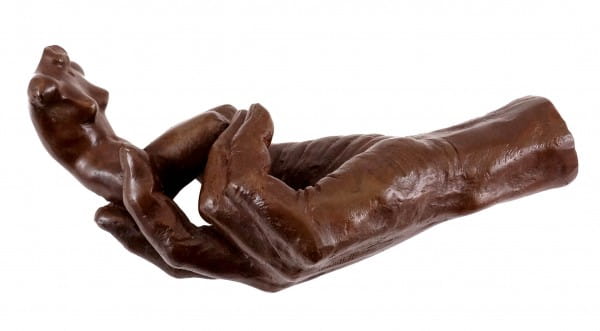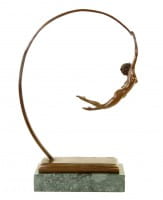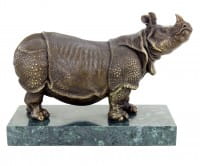Prices incl. VAT, free shipping worldwide
Ready to ship today,
Delivery time appr. 3-6 workdays










Product description
"Bronze Sculpture - Auguste Rodin - The Hand of God (1917) "
| Height | 19 cm |
| Width | 23 cm |
| Length | 18 cm |
| Weight | 1,3 kg |
The Hand of God: A Testament to Creation by Auguste Rodin
The Hand of God by Auguste Rodin stands as one of the most profound and symbolic works in the history of modern sculpture. Capturing the essence of life’s emergence from chaos, this bronze sculpture is an extraordinary representation of the act of creation. With its intricate details and deeply philosophical narrative, the artwork bridges the realms of art, theology, and humanity. The monumental hand, sculpted with anatomical precision, cradles the tender, intertwined forms of a man and woman emerging from unshaped earth—a testament to the transformative power of creation.
Auguste Rodin: The Pioneer of Modern Sculpture
Born on November 12, 1840, in Paris, France, Auguste Rodin revolutionized the art of sculpture through his ability to capture emotion, movement, and raw humanity. His works often broke with the neoclassical traditions of his time, instead favoring textured surfaces and dynamic compositions that reflected the complexity of human experience. Throughout his career, Rodin sought to explore the relationship between physical form and spiritual essence, a theme that resonates powerfully in The Hand of God.
Rodin’s journey as an artist was marked by perseverance and innovation. Initially rejected by prestigious art institutions, he went on to develop a unique sculptural language that earned him international acclaim. By the time The Hand of God was created in 1917, during the twilight of his life, Rodin had established himself as a master of capturing the sublime. This particular piece reflects his lifelong contemplation of the creative process, both divine and artistic.
The Birth of a Masterpiece
The Hand of God was conceptualized and realized in Rodin’s studio in Meudon, near Paris. The year 1917 marked not only the creation of this sculpture but also the culmination of Rodin’s illustrious career. The artist poured his reflections on life, mortality, and the nature of creation into this work, which remains one of his most spiritually evocative pieces. Originally sculpted in plaster, it was later cast in bronze, a medium that amplifies the sculpture’s timeless quality.
The work’s composition is strikingly symbolic: a colossal hand emerges from formless matter, holding two figures—a man and a woman—entwined in a moment of genesis. The unfinished texture of the surrounding earth contrasts with the smooth, delicate forms of the figures, representing the transition from chaos to order, from raw material to life.
A Profound Philosophical Statement
Rodin’s The Hand of God transcends mere visual representation, delving into the metaphysical questions of existence. The hand, depicted with veins and sinews that evoke strength and vitality, symbolizes divine power and creative force. The figures within the hand’s grasp suggest humanity’s fragility and interconnectedness, emphasizing the role of higher powers in shaping life.
The sculpture’s allegorical nature also reflects Rodin’s own perception of his craft. To him, the act of sculpting was akin to divine creation—a process of bringing forth life from inanimate material. In this way, The Hand of God serves as both a celebration of artistic creativity and a meditation on the mysteries of existence.
The Artistic Brilliance of Rodin
The technical mastery evident in this sculpture is characteristic of Rodin’s work. The detailed anatomy of the hand contrasts with the ethereal forms of the human figures, creating a harmonious interplay between realism and abstraction. The bronze medium, with its rich patina, enhances the sculpture’s visual depth, adding an almost otherworldly glow that shifts with the light. This dynamic quality invites viewers to engage with the work from multiple perspectives, revealing new layers of meaning with each encounter.
Rodin’s Legacy and the Impact of The Hand of God
The Hand of God stands as a defining work within Rodin’s oeuvre, encapsulating the themes that permeate his art: creation, transformation, and the divine. By placing humanity within the grasp of a larger force, Rodin conveys both the vulnerability and potential of human existence. This sculpture continues to inspire artists, philosophers, and art lovers worldwide, serving as a timeless reminder of the creative power inherent in both the divine and the human spirit.
A Collector’s Dream
For art collectors, The Hand of God is a rare and invaluable piece. Its historical significance, combined with Rodin’s reputation as a pioneer of modern sculpture, makes it a prized addition to any collection. The signature of Auguste Rodin affirms its authenticity and connection to the artist’s visionary legacy.
A Timeless Symbol of Creation
In The Hand of God, Auguste Rodin offers a glimpse into the eternal act of creation, presenting a work that is as thought-provoking as it is visually stunning. Whether displayed in a private collection, a museum, or a public space, this sculpture resonates with universal themes of life, divinity, and the transformative power of art. It invites viewers to reflect on their place in the grand narrative of creation, making it a timeless masterpiece that transcends the boundaries of time and culture.
Our advantages
free shipping
Worldwide free shipping
14 days money back
You can cancel your order
within 14 days
secure payment services
Paypal, Master Card, Visa, American Express and more





























































